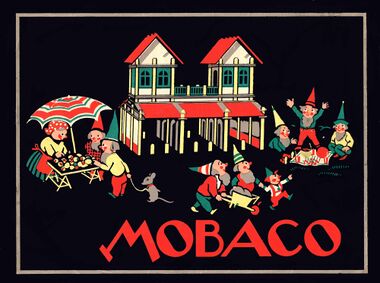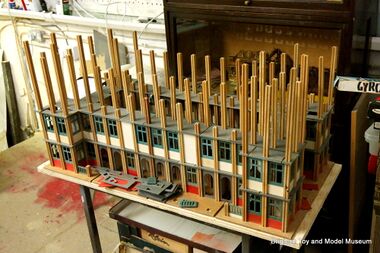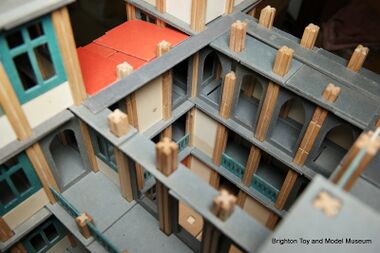 |
| Mobaco manual, front cover |
Mobaco was a building construction set popular in the Netherlands between the wars. Consisting of baseboards, slotted wooden rods and panel pieces that drop down between them, it's reminiscent of a giant-sized
Bayko set, and it's generally reckoned to have been the inspiration behind the smaller-sized Bakelite-based system designed by Charles Plimpton.
Since we have a significant quantity of Mobaco, we felt that it was high time that we built something from it, as although our construction set cabinets are pretty full, Mobaco buildings are large enough that we could display something made with the system
on top of a cabinet.
Flicking through our copy of the No.4 set manual, there was only one real contender: the monster-sized five-storey Town Hall or School featured as a decorative and inspirational line-drawing on the last page of the manual, making it (apparently) the biggest official Mobaco building design.
.jpg/480px-Large_Town_Hall_or_University_Building%2C_lineart_(Mobaco).jpg) |
| No sense in starting small, eh? |
Matters were somewhat complicated by our never having actually made anything with Mobaco before, and the fact that the picture didn't come with any sort of plans or instructions.
 |
| The second floor completed |
Mobaco is a little bit more tricky than it looks, at least, for very ambitious models – the floor-pieces hold everything together, and have to be laid as double overlapping layers, a process that becomes progressively more difficult as a large building progresses and one starts to run out of key pieces. Another complication is the careful stacking of vertical pillars to achieve the required height, given the bizarre combinations of pillar-heights and piece heights. Although 90% of the building went up the same day, it took over a week of additional intermittent fiddling to get the complete building finished, with the process of carefully pulling out rods and replacing them with combinations of smaller rods making the process feel something like a cross between assembling a 3D jigsaw puzzle and playing
Jenga.
 |
| M.C Escher must have had nightmares that looked like this |
The final completed masterpiece(!) will be appearing in the museum for the 25th anniversary celebrations, starting on the 7th May 2016.
.jpg/480px-Great_Central_Railway_coach%2C_gauge1%2C_1904_(Bing_for_Bassett-Lowke).jpg)
.jpg)


.jpg/480px-Large_Town_Hall_or_University_Building%2C_lineart_(Mobaco).jpg)




